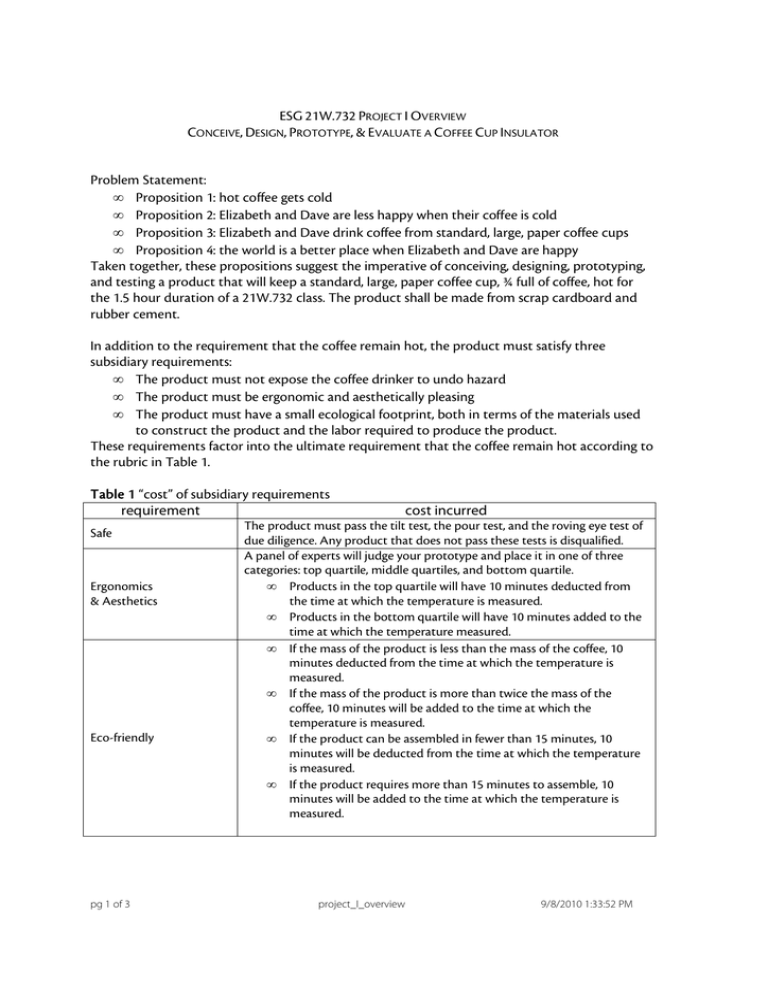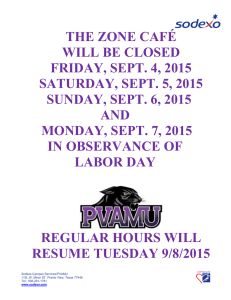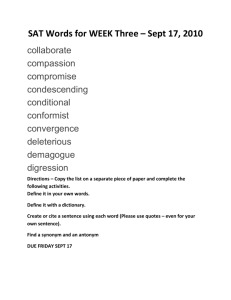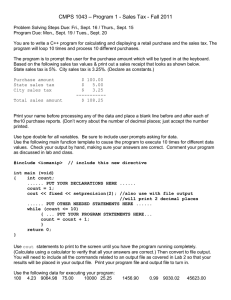Document 13508080
advertisement

ESG 21W.732 PROJECT I OVERVIEW CONCEIVE, DESIGN, PROTOTYPE, & EVALUATE A COFFEE CUP INSULATOR Problem Statement: • Proposition 1: hot coffee gets cold • Proposition 2: Elizabeth and Dave are less happy when their coffee is cold • Proposition 3: Elizabeth and Dave drink coffee from standard, large, paper coffee cups • Proposition 4: the world is a better place when Elizabeth and Dave are happy Taken together, these propositions suggest the imperative of conceiving, designing, prototyping, and testing a product that will keep a standard, large, paper coffee cup, ¾ full of coffee, hot for the 1.5 hour duration of a 21W.732 class. The product shall be made from scrap cardboard and rubber cement. In addition to the requirement that the coffee remain hot, the product must satisfy three subsidiary requirements: • The product must not expose the coffee drinker to undo hazard • The product must be ergonomic and aesthetically pleasing • The product must have a small ecological footprint, both in terms of the materials used to construct the product and the labor required to produce the product. These requirements factor into the ultimate requirement that the coffee remain hot according to the rubric in Table 1. T able 1 “cost” of subsidiary requirements Table requirement Safe Ergonomics & Aesthetics Eco­friendly pg 1 of 3 cost incurred The product must pass the tilt test, the pour test, and the roving eye test of due diligence. Any product that does not pass these tests is disqualified. A panel of experts will judge your prototype and place it in one of three categories: top quartile, middle quartiles, and bottom quartile. • Products in the top quartile will have 10 minutes deducted from the time at which the temperature is measured. • Products in the bottom quartile will have 10 minutes added to the time at which the temperature measured. • If the mass of the product is less than the mass of the coffee, 10 minutes deducted from the time at which the temperature is measured. • If the mass of the product is more than twice the mass of the coffee, 10 minutes will be added to the time at which the temperature is measured. • If the product can be assembled in fewer than 15 minutes, 10 minutes will be deducted from the time at which the temperature is measured. • If the product requires more than 15 minutes to assemble, 10 minutes will be added to the time at which the temperature is measured. project_I_overview 9/8/2010 1:33:52 PM T able 2 Project 1 workflow/assignments, roughly in order of occurrence Table activity deliverables sketches and scrawlings in your notebook that identify: • functions and configurations suitable for cardboard (~10) in notebook brainstorming • design spaces for coffee container insulators (~3) in notebook • design embodiments of coffee keeper warmers (~3 for each space, ~9 total) in notebook • rough FRDPARRC table for each design space (in notebook) • selection criteria table (in notebook) • 4 page .pdf document with scans/photos from your notebook: your selected design, the winnowing/selection criteria you used to choose this design, the FRDPARRC & rough FRDPARRC table, and the big questions you have that are critical to your design selection • be ready to deliver an informal presentation of design (with .pdf) • white paper on heat transfer (see white paper assignment) • very informal proposal for what experimentation you’ll do on Sept 14 (in notebook) due dates Sept. 9 (done in class) Sept. 13 (before class) Sept. 13 (before class) Sept. 13 (before class) Sept. 13 (before class) Sept. 13 (before class) Sept. 13 (before class) Sept. 13 (before class) Sept. 14 (before class) Sept. 16 (before class) • reading commentary in your notebook on Sept. 16 (before class) other things • (these are easy to accomplish much earlier than the official due date) • Take the myers­briggs test, printout the results, and read how to interpret the results. reading commentary on Oakley’s effective teams article, Philip’s member of a team article, and theory of multiple intelligences ...in your notebook Sept. 16 (before class) Test at: http://www.engr.ncsu.edu/learningstyles/ilsweb.html propose design prototype implement test other things report debrief madlib project proposal prepare your pitch for design review (semi­formal design review presentation) product prototype—document the prototype, its construction, & its characteristics in your notebook; be sure to take photos construct the final device for evaluation in class on Sept 20 test results in notebook & photo documentation of results comment on readings in your notebook: • • • Sept. 16 (before class) Sept. 16 (before class) nebulous Sept. 21 (before class) Sept. 21 (done in class) Sept. 21 (before class) questions to consider to create a team contract (courtesy of the MIT leadership folks) forming, norming, storming, performing... pirate's creed of ethics team composition recommendations (in your notebook) progress report, Sept 2»Sept. 18ish (to Elizabeth in an e­mail memo) individual web site preparation of oral presentation for delivery on Sept 27 written report graphics package reflection memo to Neal thoughts in notebook performance review w/ Dave Sept. 21 (before class) Sept. 19 (before midnight) Sept 20ish Sept. 28 (before class) Sept. 28 (before class) Sept. 28 (before class) Sept. 30 (before class) Sept. 30 (in class) Sept. 29 ± 2 Expect project II team selection on Sept. 20, so during the first weeks of class, give consideration to which other students you’d like to work with on the 2nd project. Project I assignments will overlap with additional Project II assignments (not listed here) between Sept 20 and Sept 27. pg 2 of 3 project_I_overview 9/8/2010 1:33:52 PM T Table Taable ble 3 tentative class activities, early September date Thurs, Sept 9 Mon, Sept 13 Tues, Sept 14 Thurs, Sept 16 Mon, Sept 20 Tues, Sept 22 ± 2 Thurs, Sept 23 Mon, Sept 27 Tues, Sept 28 Thurs, Sept 30 pg 3 of 3 activities introductions: us introduction to the design process, esp. brainstorming, winnowing, & FRDPARRC notebooks brainstorming sessions overview of the homework design presentations and preliminary reviews technical discussion & preparation for Tuesday’s explorations proposal & report structure oral presentations I overview of the homework explorations proposal presentations notebook review reading discussion grouping logic web presence talking to strangers overview of the homework guest speakers device show & tell device testing reading discussion project II team selection overview of project II overview of the homework project II, team meeting 1 individual meetings w/ Dave & Elizabeth (bring your notebook) project II, team meeting 2—concept choice possible hobby shop orientation reading discussion overview of the homework oral reports, project I about posters and elevator pitches about MIT students working in teams overview of the homework team time possible hobby shop orientation project I debrief reading discussion project II poster & elevator pitch overview of the homework project_I_overview 9/8/2010 1:33:52 PM MIT OpenCourseWare http://ocw.mit.edu 21W.732 / ESG.21W732 Science Writing and New Media Fall 2010 For information about citing these materials or our Terms of Use, visit: http://ocw.mit.edu/terms.






